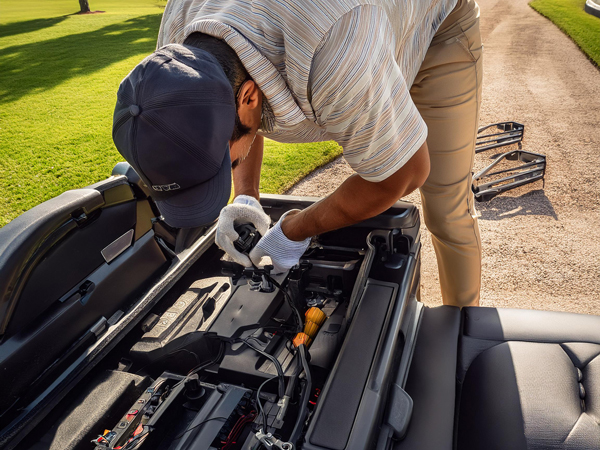Golf Cart Lithium Battery Information
Signs Your Golf Cart Battery Needs Replacement
Golf carts have become an integral part of leisurely activities, especially on golf courses, in gated communities, and even on large properties. The key component that keeps these carts running smoothly is the battery. But like any other battery, your golf cart battery will eventually need replacement. Knowing when to replace it can save you from unexpected breakdowns and unnecessary frustration.
Understanding Golf Cart Batteries
Before diving into the signs indicating a need for replacement, it’s essential to understand the types of batteries commonly used in golf carts. This knowledge will help you make an informed decision when it’s time to purchase a new one.
Types of Golf Cart Batteries
Golf carts typically use one of two types of batteries: lead-acid or lithium-ion.
Lead-Acid Batteries
Lead-acid batteries, often referred to as deep cycle batteries, are the traditional choice for golf carts. They are reliable and less expensive than their lithium counterparts. However, they require regular maintenance, such as checking water levels and cleaning terminals.
Lithium-Ion Batteries
Lithium golf cart batteries are becoming increasingly popular due to their efficiency and low maintenance. They are more expensive upfront but offer a longer lifespan and faster charging times. They also weigh less, which can improve the performance of your golf cart.
Signs Your Golf Cart Battery Needs Replacement
Now that you have a basic understanding of golf cart batteries, let’s explore the signs that indicate it’s time for a battery replacement.
Reduced Driving Range
One of the most noticeable signs that your golf cart battery needs replacement is a reduced driving range. If you find that your cart doesn’t travel as far on a full charge as it used to, it may be time to consider a new battery. Over time, the capacity of a battery diminishes, meaning it can’t hold as much charge as it once did.
Slow Acceleration
If your golf cart is slow to accelerate or struggles when climbing hills, this could be another sign of a failing battery. The power needed for acceleration and climbing is significant, and a worn-out battery may not be able to supply it effectively.
Longer Charging Time
When your battery starts to take longer to charge than usual, it might be nearing the end of its life. A healthy battery should charge within the expected time frame specified by the manufacturer. If it consistently takes longer, it may be time for a replacement.
Physical Signs of Damage
Check the battery for any physical signs of damage. This includes leaking, corrosion on the terminals, or bulging of the battery case. These are clear indicators that your battery may be compromised and needs immediate attention. Corrosion can often be cleaned, but if the problem persists, replacement is the safest option.
Age of the Battery
Even if your battery seems to be functioning well, consider its age. Lead-acid batteries generally last between 4 to 6 years, while lithium golf cart batteries can last up to 10 years. If your battery is nearing the end of its expected lifespan, it’s wise to start planning for a replacement before you experience a breakdown.
How to Extend Your Golf Cart Battery’s Life
While replacement is inevitable, certain practices can help extend the life of your golf cart battery.
Regular Maintenance
For lead-acid batteries, regular maintenance is crucial. Ensure that the water levels are appropriate and that the terminals are clean. Use a mixture of baking soda and water to clean any corrosion.
Proper Charging Practices
Avoid letting your battery completely discharge before recharging it. Regular charging, even after short uses, can help maintain battery health. For lithium batteries, follow the manufacturer’s charging guidelines to optimize lifespan.
Storage Conditions
Store your golf cart in a cool, dry place when not in use. Extreme temperatures, whether hot or cold, can adversely affect battery performance and longevity. If storing for an extended period, ensure the battery is fully charged and consider disconnecting it to prevent discharge.
Choosing the Right Replacement Battery
When it’s time to replace your golf cart battery, consider the following factors to choose the right one for your needs.
Performance Needs
Assess your performance needs. If you use your golf cart frequently or on challenging terrain, a lithium battery might be a better choice due to its superior performance and longevity.
Budget Considerations
While lithium batteries offer many advantages, they come at a higher price. If budget is a concern, lead-acid batteries are a more economical choice, though they require more maintenance.
Environmental Impact
Lithium batteries are more environmentally friendly than lead-acid batteries. They last longer and are more efficient, reducing the frequency of replacements and the amount of waste produced.
Conclusion
Recognizing the signs that your golf cart battery needs replacement can save you from unexpected inconveniences and maintain the performance of your cart. Whether you choose a traditional lead-acid battery or opt for a modern lithium golf cart battery, ensure you understand your needs and the maintenance involved. With the right care and timely replacement, your golf cart will serve you reliably for many years to come.

